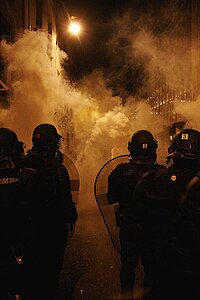
Photo from wikipedia
Abstract Purpose To evaluate the short- (within 90 min) and long-term (after 21 days of treatment) effects of an artificial tear containing carbomer, hyaluronic acid, glycerol, and medium-chain triglycerides in patients with… Click to show full abstract
Abstract Purpose To evaluate the short- (within 90 min) and long-term (after 21 days of treatment) effects of an artificial tear containing carbomer, hyaluronic acid, glycerol, and medium-chain triglycerides in patients with mild-to-moderate dry eye symptoms. Methods Subjects received the tested artificial tears in the right eye and control artificial tears in the left eye and were assessed 10, 30, 60, and 90 min after instillation in the short-term study phase. They received the study product in both eyes in the long-term phase. Non-invasive break-up time (NIBUT), tear lipid layer pattern, tear evaporation, and tear film objective optical dynamics (TFOOD) were measured in controlled environmental conditions. Results In total, 32 patients (10 males, mean age 42 ± 11 years) were enrolled. During the short-term phase, NIBUT increased significantly in the right eyes at all time points compared with baseline (all p < 0.05). Conversely, in the left eyes, NIBUT increased significantly at 10 and 30 min (p < 0.05). The tear evaporation values increased at 10 min and decreased at 30 and 60 min (p < 0.05) in the right eyes, while they increased only at 10 min (p < 0.05) in the left eyes. Compared with baseline, the TFOOD was significantly more stable at all time points in the right eyes (p < 0.05), while it was more stable at 10 and 30 min in the left eyes (p < 0.05). In the long-term phase, treated eyes showed a significant increase in NIBUT values, a significant reduction of tear evaporation, a significant improvement of tear lipid layer pattern, and a more stable TFOOD compared with baseline (all p < 0.05). Symptoms, measured with the Ocular Surface Disease Index questionnaire, were also significantly reduced compared with baseline (p < 0.05). Conclusion The tested product increased tear film stability and reduced tear evaporation, normalizing lipid layer pattern and reducing symptoms in the short- and long-term observation.
Journal Title: Current Eye Research
Year Published: 2022
Link to full text (if available)
Share on Social Media: Sign Up to like & get
recommendations!